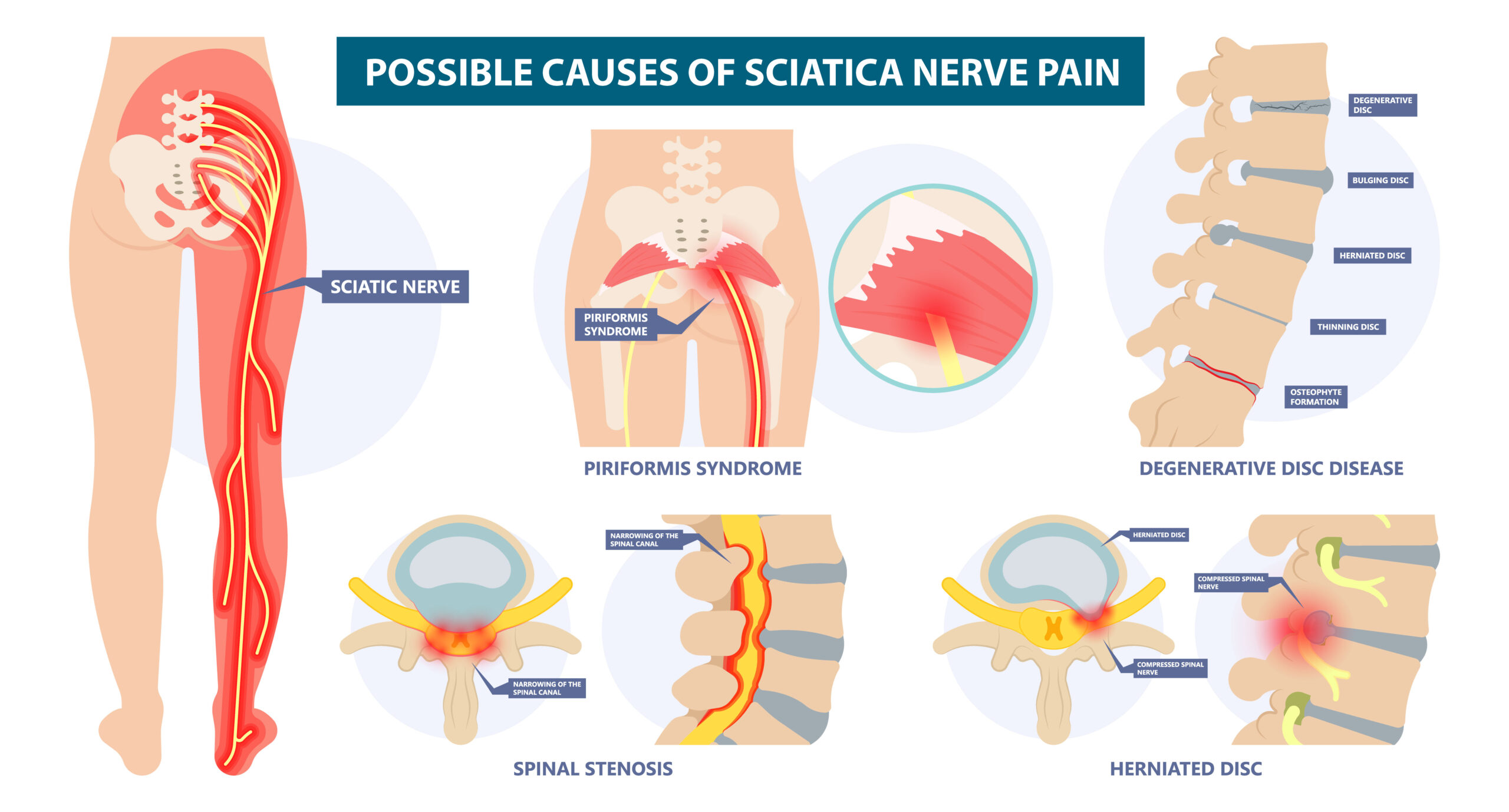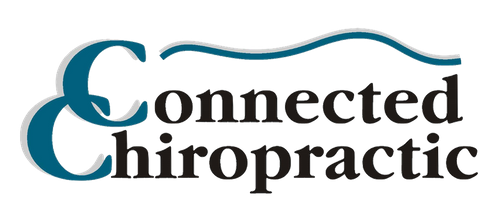Treating Sciatic Pain with Chiropractic Care
If you are experiencing Sciatic Nerve Pain, you are not alone. Sciatica is a common condition that about 40% of people in the U.S. suffer from during their lifetime. Connected Chiropractic’s board-certified chiropractic care in Johnstown, CO is an excellent, non-invasive, non-pharmaceutical option for treating and easing Sciatic Nerve Pain quickly.

What Causes Sciatica?
Sciatic nerve pain is often caused by an injury or irritation of the sciatic nerve which is located in the buttock/gluteal area of the body. The sciatic nerve is the thickest and longest nerve in the entire human body. It is made up of five nerve roots, two of them start in the lower back lumbar region and the other three start at the end of the spine or what we call the sacrum region. All five of these nerves bundle together to form a right and left side sciatic nerve. These nerves run through each hip, buttock, and down the back of the leg terminating just below the knee. From there, the sciatic nerve branches out into smaller nerves that continue down the leg into the foot and toes.
Sciatic pain is the typical term used to define pain, weakness, numbness, and/or tingling that originates in the lower back and “radiates” down the leg and sometimes into the feet and toes.
What are the Symptoms of Sciatic Pain?
Sciatic nerve pain can manifest in different ways depending on where the nerve irritation is occurring. Oftentimes, sciatica will feel like:
- Moderate to severe pain in the lower back, buttock area and pain that radiates down your leg.
- Numbness, burning sensation, or weakness in your lower back, buttock, leg, feet, or toes.
- Pain that worsens with movement; inability to move like you normally would.
- A sharp and stabbing pain, or it can feel like a burning or electrical sensation. Often, numbness described as a “pins and needles” sensation will occur in parts of your leg, feet, and/or toes.
- Loss of bowel and bladder control is also a symptom.
Sciatic pain may be sporadic or constant and is usually irritated by sitting or standing in place for extended periods of time.
Sciatic nerve pain is most often experienced in just one leg, however, it is possible to experience it in both legs. This all depends on what part of the sciatic nerve is being pinched or irritated.
Risks for Developing Sciatic Nerve Pain
Some individuals are more prone to sciatica than others. Some of the risk factors and causes of Sciatic Pain include:
Excess Weight: The more weight a body must carry, the harder the back muscles have to work. This extra strain can lead to sciatic nerve pain and other back issues. Maintaining an optimal weight is critical to long-term health.
A Weak Core: Strong core muscles mean better support for the lower back, which in turn will help thwart sciatic nerve pain.
Getting Older: Aging causes normal wear and tear on the disks in our spine. The sciatic nerve can become irritated or pinched due to the changes and shifting alignment of the body’s bones, spinal disks, and ligaments.
Osteoarthritis: Arthritis has the potential of damaging the spine which puts nerves at risk of becoming irritated, pinched, and permanently injured. This can be the reason for chronic sciatic nerve pain.
Health and Fitness: When overall health suffers, physical fitness can slide downhill. Weak abdominal muscles often lead to lower back strains and sprains. People who drink heavily, smoke, and/or live a sedentary lifestyle have a much higher risk of sciatic nerve pain.
Activities, Sports, and Occupation: Stressful activity, sports, and occupational hazards that involve routine heavy lifting or continuous bending can increase the risk of sciatic nerve pain.
Spinal Conditions: Herniated disks, degenerative disc disease, spinal stenosis, spondylolisthesis, osteoarthritis, tumors in the lumbar spine, piriformis syndrome, and cauda quina (rare condition that causes loss of bowel and bladder control) can all cause sciatica.
Diabetes: Individuals with diabetes have a higher risk of nerve damage which increases the likelihood of sciatic nerve pain developing.
Smoking: Long-term use of nicotine can lead to damage and deterioration of spinal tissues; it can also weaken bones which contributes to the wearing down of the disks in the vertebra.
Pregnancy: Weight gain during pregnancy is usually not the reason for sciatic nerve pain in pregnant women. During pregnancy, the hormonal changes in a woman’s body cause ligaments to loosen up. Loosening of the ligaments can cause misalignment of the spine and some slipping of disks which can irritate or pinch the sciatic nerve. The position and weight of the baby can also create extra pressure on the sciatic nerve and trigger pain.
Sciatic nerve pain during pregnancy usually goes away after birth and can be eased during pregnancy through regular chiropractic care.
Diagnosing and Treating Sciatic Pain with Chiropractic Care
Diagnosis
First, the Board-Certified Chiropractor at Connected Chiropractic will review your medical history and discuss all of your symptoms. We then perform simple tests that help us pinpoint and diagnose the source of the sciatic nerve pain and determine whether or not there may be a problem with one of your disks. Other stretches and specific motions will also be evaluated to pinpoint pain and check your muscle flexibility and strength.
Depending on what your Chiropractor finds during your physical exam, a spinal X-ray may need to be ordered.
Your Chiropractic Treatment May Include:
Chiropractic Adjustments: Connected Chiropractic’s skilled chiropractor will provide a variety of spinal adjustments using different techniques to realign the vertebra, resolve limited spinal movement, and work with any herniated disc(s) to get them back into position and take pressure off the sciatic nerve. Adjustments will not only help with sciatic pain relief but will also help ease muscle spasms and promote long term relief.
Spinal Decompression: Over time, discs in the spine can become thinner resulting in pinched nerves and spine compression. Decompression relieves the compression of nerves that cause sciatic pain through gentle stretching that gives the unhealthy discs the space they need to heal and relieve pressure caused by the vertebrae of the spine.
Massage Therapy: Connected Chiropractic’s massage therapy provides effective and soothing relief of sciatic pain. Massage has multiple health benefits outside of relaxation. When partnered with chiropractic care, it can drastically improve and heal sciatic pain. By inducing deep muscle relaxation, endorphins are released that act as the body’s natural painkiller.
Heat and Cold Therapy: Heat releases tight muscles and cold slows down blood flow to ease inflammation. Connected Chiropractic uses alternating cold and heat therapy to provide quick relief from sciatic pain.
Ultrasound Therapy: Gentle, therapeutic heat generated by ultrasound waves penetrate deep into the body’s tissues and is a good therapy for sciatic pain. It improves circulation (promoting healing) and lessens cramping, swelling, muscle spasms, and pain.
TENS (transcutaneous electrical nerve stimulation) Therapy: TENS is a small, non-invasive, nerve stimulating device that relaxes the back muscles, eases spasms, increases endorphins, and reduces pain. TENS therapy is another treatment that can dramatically reduce and heal sciatic pain.
Interferential Current Therapy: Interferential current therapy works by sending small amounts of electrical stimulation to damaged tissues in the body. Unlike other methods of low frequency electrical stimulation, these currents encounter a low electrical resistance and can thus penetrate deeply. The therapy is meant to boost the body’s natural process for responding to pain, increase blood flow, and the encourage the production of hormones that promote healing…all of which reduce the symptoms caused by sciatica.
Exercise Therapy & Education: Moving in particular ways can worsen sciatic pain. Connected Chiropractic educates patients suffering from sciatic nerve pain about the types of exercises to avoid and also about the types of exercises that will help to heal sciatic nerve pain. Most exercise and stretching recommendations are ones that patients can do at home.
Lifestyle Changes: Connected Chiropractic’s Skilled Staff helps patients evaluate all aspects of their lives. With proper guidance and education for strengthening back muscles, sciatic nerve pain can be prevented.
The “Three Ts” that are Crucial for Health & Wellness
If functioning properly, your body is a resilient, self-healing, and self-regulating system.
At Connected Chiropractic we treat the whole body to ensure that the body, central nervous system, and mind are working in tandem throughout the healing process. We believe the best way to treat and prevent sciatic pain is by understanding the “Three Ts”:
Thoughts, Toxins, and Trauma
Our mission is to ensure that everyone we treat has a better understanding of the “Three Ts” and the impact they have on your health and wellness. All of the factors and causes listed above fall easily into one category, many fall into 2 or more!
Schedule Sciatic Pain Healing Now…
Clinic Location
32 S Rutherford Ave,
Johnstown, CO, United States, Colorado
(970) 587-7029
Clinic Hours:
Monday: 9am-11am / 3pm – 6pm
Tuesday: 9am-11am / 3pm – 6pm
Wednesday: 9am-11am / 3pm – 6pm
Thursday: 9am-11am / 3pm – 6pm
Friday: CLOSED
Saturday: CLOSED
Sunday: CLOSED
What Our Patients Are Saying...
At Connected Chiropractic, we’re proud to have earned the trust and loyalty of the Johnstown and Northern Colorado communities. From helping individuals overcome complex issues to supporting families in achieving their wellness objectives, we take pride in providing effective care that makes a difference. Hear what others have to say about our chiropractic clinic and how we successfully manage their health!
